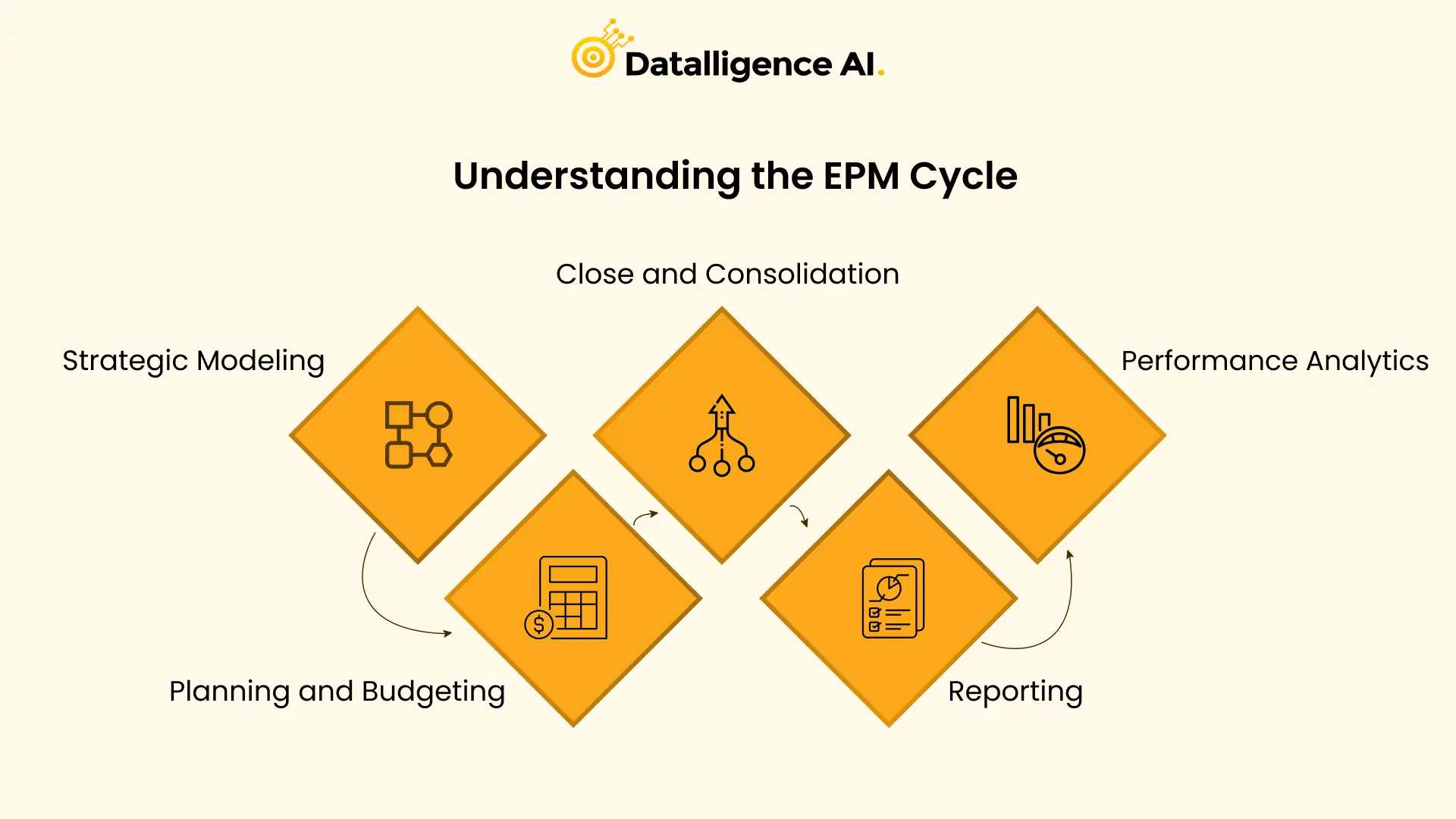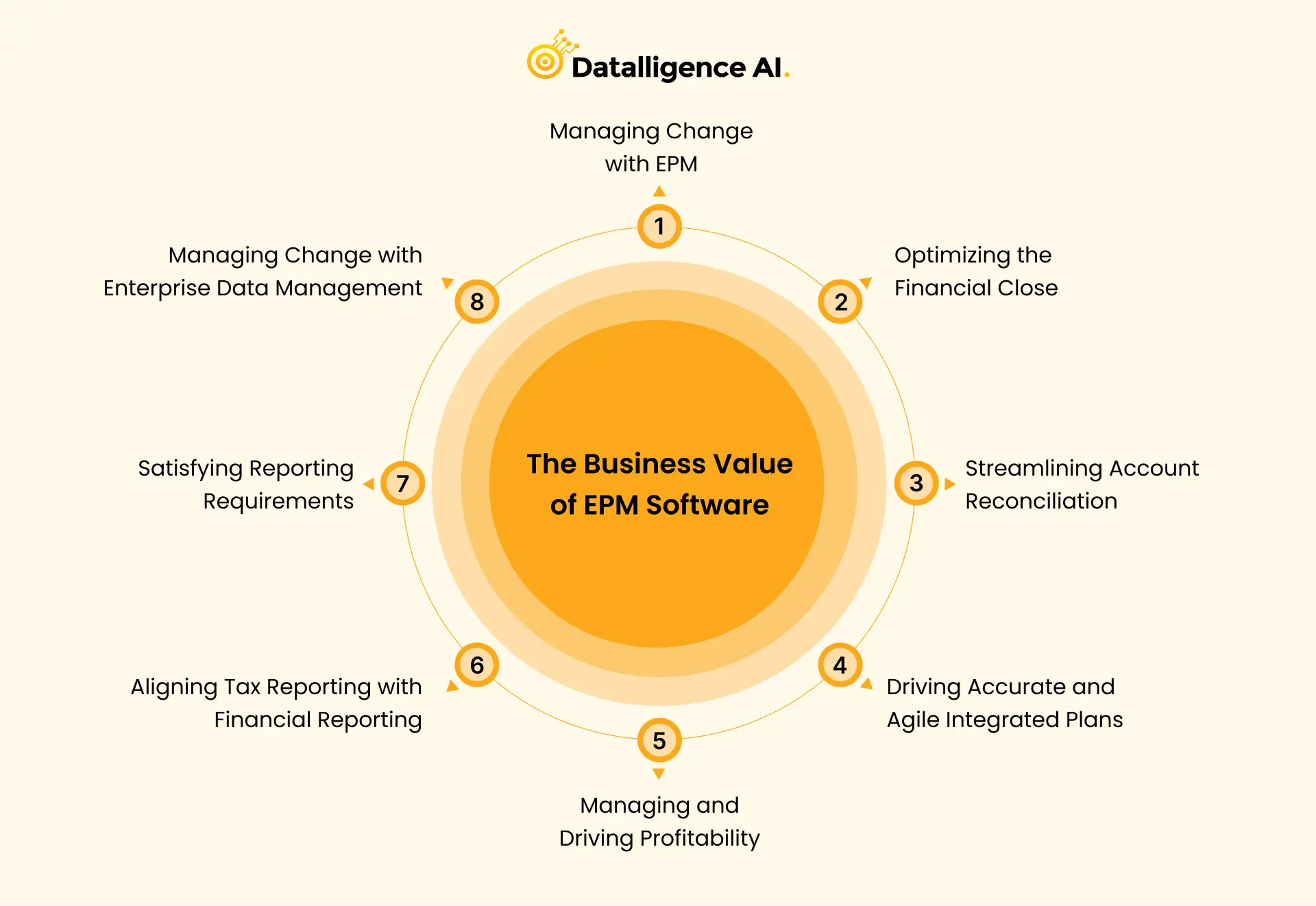In today’s competitive business landscape, organizations need effective tools to analyze, understand, and improve their performance. This is where Enterprise Performance Management (EPM) software comes into play. EPM encompasses a range of processes, strategies, and software solutions designed to help organizations plan, budget, forecast, analyze, and report on their business performance. In this comprehensive guide, we will delve into the world of EPM, exploring its various components, software solutions, benefits, and evolution over time.
Table of Contents
Evolution of Enterprise Performance Management(EPM)
EPM has a rich history that dates back several decades. Before the advent of computers, enterprises managed performance manually through meetings and discussions. In the 1970s, the first EPM software applications became available, revolutionizing how organizations collected budgeting and financial information for reporting purposes. The introduction of spreadsheets in the 1980s further automated budgeting and reporting processes, replacing manual worksheets. Alongside this, dedicated EPM software packages emerged, streamlining financial consolidation, reporting, and planning processes.
Over time, EPM software platforms transitioned from Windows-based client/server systems to web-browser-based applications. Today, there is a growing demand for cloud-based EPM software, also known as Software-as-a-Service (SaaS). Cloud-based EPM solutions offer affordability, scalability, and ease of implementation, eliminating the need for costly infrastructure and allowing organizations to focus on growth opportunities.
Understanding the EPM Cycle

The EPM cycle encompasses several key processes that drive improved performance across the organization. These processes include:
Step 1. Strategic Modeling
Strategic modeling enables organizations to develop long-range forecasts and analyze trends. It provides the necessary insights to make informed decisions and align strategies with planning and execution. By leveraging strategic modeling, managers gain confidence in the accuracy of their projections, reports, and audits.
Step 2. Planning and Budgeting
EPM software empowers organizations to streamline their planning and budgeting processes. From creating detailed budgets to forecasting future performance, EPM solutions offer flexibility and scalability. By aligning planning across the enterprise, organizations can respond more effectively to changes and develop agile forecasts for all lines of business.
Step 3. Close and Consolidation
Closing the books and consolidating financial results is a critical aspect of EPM. With EPM software, organizations can streamline the financial close process, adapt to changing regulatory requirements, and deliver faster, more accurate insights to stakeholders. Efficient close and consolidation processes provide transparency and confidence in financial reporting.
Step 4. Reporting
EPM software revolutionizes financial reporting by providing standardized, consistent formats for reporting financial data. It enables organizations to consolidate briefs into executive reports, distribute report content to stakeholders, and integrate financial decisions. With EPM reporting capabilities, organizations can satisfy all reporting requirements, reducing the need for multiple reporting systems.
Step 5. Performance Analytics
Analyzing performance is a fundamental aspect of EPM. EPM software allows organizations to monitor and manage key performance indicators (KPIs) regularly. By leveraging analytics, managers can identify trends, recognize key insights, and make data-driven decisions. Performance analytics enable organizations to identify areas of improvement and drive profitability.
The Business Value of EPM Software

In today’s fast-paced and uncertain business environment, EPM software offers critical value to organizations. By embracing EPM, organizations can effectively manage change, optimize the financial close process, streamline account reconciliation, drive accurate and agile integrated plans, manage and drive profitability, align tax reporting with financial reporting, and satisfy reporting requirements.
1. Managing Change with EPM
Change is inevitable in any organization. EPM software provides organizations with the agility to adapt to constant change, new competitors, and economic uncertainty. By leveraging EPM processes, organizations can understand their data, make better business decisions, and manage their businesses effectively in dynamic environments.
2. Optimizing the Financial Close
In a rapidly changing regulatory environment, organizations need to adapt quickly and deliver accurate insights to stakeholders. EPM software streamlines the financial close process, allowing organizations to meet regulatory requirements, reduce data-related delays, and report with confidence and insight.
3. Streamlining Account Reconciliation
Account reconciliation is a crucial aspect of the financial close process. EPM software helps organizations efficiently manage and improve global account reconciliation by leveraging automation, addressing security and risk, and ensuring data accuracy and integrity.
4. Driving Accurate and Agile Integrated Plans
The digital economy demands more than spreadsheets and department-oriented planning processes. EPM software enables organizations to align planning across the enterprise, develop agile forecasts for all lines of business, and respond faster and more effectively to changes. By integrating planning processes, organizations can create a better vision for the future.
5. Managing and Driving Profitability
To thrive in uncertain times, organizations must effectively manage and drive profitability. EPM software provides insights into cost and profitability dimensions, enabling organizations to make informed decisions on where to invest limited resources. By leveraging EPM, organizations can improve profitability and stay ahead of the competition.
6. Aligning Tax Reporting with Financial Reporting
Changing tax laws requires organizations to manage their tax affairs differently. EPM software supports effective tax reporting by connecting processes, data, and metadata shared by tax and finance departments. This alignment ensures accurate financial planning, financial close, and regulatory reporting.
7. Satisfying Reporting Requirements
Organizations often have to comply with multiple reporting standards. EPM software reduces the need for multiple reporting systems, ensuring accuracy, completeness, and the availability of the most current information. By leveraging EPM reporting capabilities, organizations can streamline their reporting processes and meet regulatory obligations.
8. Managing Change with Enterprise Data Management
Whether migrating applications to the cloud or spearheading business and financial transformations, enterprise data management platforms ensure data accuracy and integrity. By aligning data and master data, organizations can manage change effectively and drive improved performance.
The Future of EPM: Next-Generation Solutions
EPM software has evolved, incorporating emerging technologies such as artificial intelligence (AI) and machine learning (ML). These technologies are transforming the EPM landscape by closing the gap between analysis and action, improving decision-making, and automating routine tasks.
Next-generation EPM solutions focus on analysis to action, empowering finance teams to spend less time on low-value tasks and more on high-value analysis. By leveraging AI and ML, EPM software detects hidden patterns and insights in historical data, enabling better decision-making across tactical, operational, and strategic levels.
Choosing the Right EPM Solution
Selecting the right EPM solution is crucial for organizations aiming to maximize their performance. When evaluating EPM software, consider factors such as deployment models, innovation capabilities, flexibility of modeling, and integration with other business applications. Cloud-based EPM solutions offer advantages in terms of implementation time, cost-effectiveness, and scalability.
Popular EPM software options include Oracle Hyperion, OneStream XF, Anaplan, Host Analytics, and InfoProphix. These solutions provide comprehensive EPM functionalities, supporting strategic modeling, planning, budgeting, consolidation, reporting, and analytics. Choosing a solution that aligns with your organization’s specific needs and goals is essential.
Introducing Datalligence.AI: Your EPM Partner
At Datalligence.AI, we understand the complexities of Enterprise Performance Management and the critical role it plays in driving organizational success. Our team of experts specializes in EPM solutions, helping organizations implement, optimize, and leverage EPM software to improve performance and achieve their strategic goals.
As a trusted EPM partner, we offer a range of services, including EPM software selection, implementation, customization, and support. We work closely with our clients to understand their unique requirements and tailor EPM solutions that align with their business objectives. With Datalligence.AI, you can unlock the full potential of EPM and take your organization’s performance to new heights.
In conclusion, Enterprise Performance Management (EPM) is a powerful tool that enables organizations to connect their strategy with planning and execution. By leveraging EPM software, organizations can streamline processes, drive improved performance, and make data-driven decisions. As the business landscape continues to evolve, EPM solutions will play a crucial role in helping organizations navigate change, optimize financial processes, and achieve strategic objectives. Partner with Datalligence.AI to unleash the power of EPM and drive your organization’s success.
For more information on how Datalligence.AI can help your organization with EPM solutions, contact us at tanya@datalligence.co or visit our website at www.datalligence.ai.











